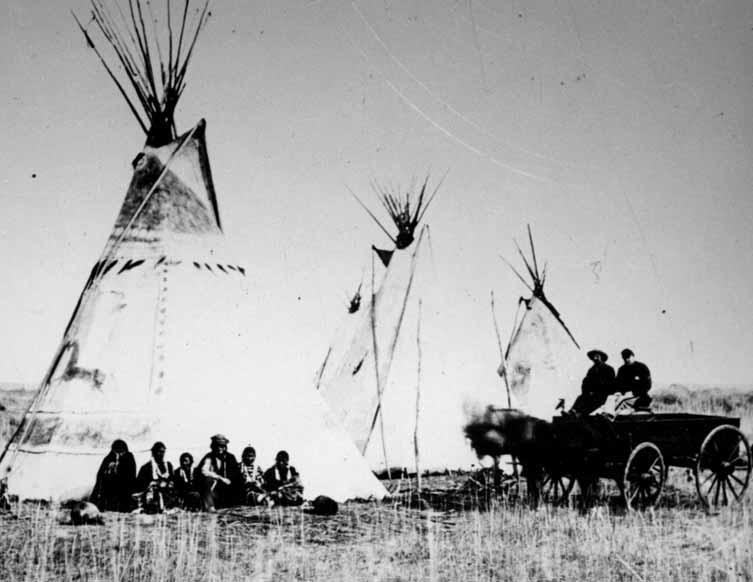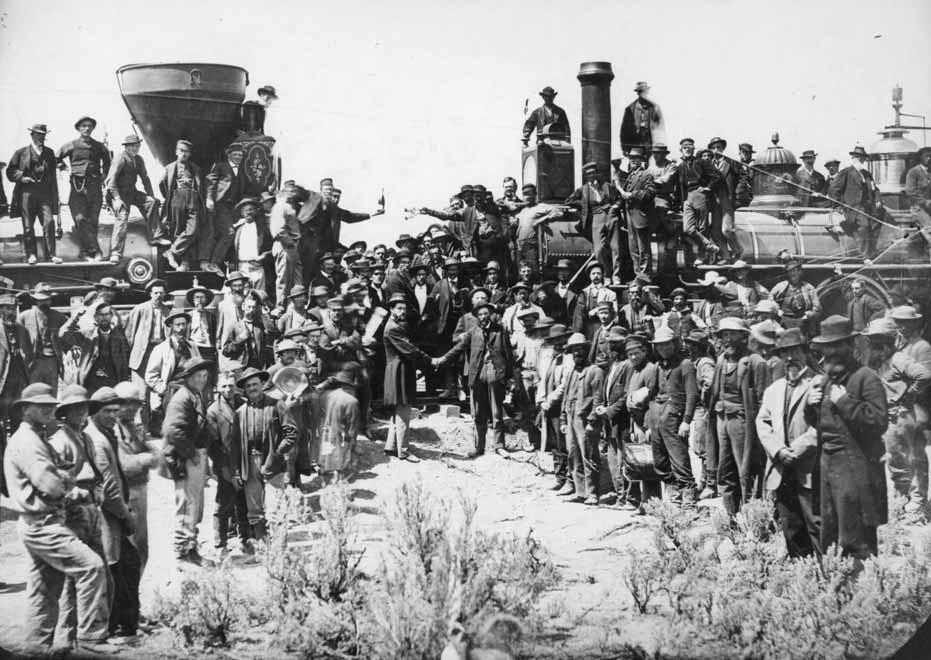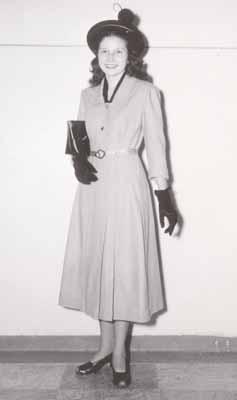
31 minute read
"Amusements and Recreations...Makes Our Working Hours Profitable": Utah 4-H, 1940-1960
“Amusements and Recreations . . . Makes Our Working Hours Profitable”: Utah 4-H, 1940–1960
By HOLLY BUCK
Precocious Wanda Campbell, in an essay detailing the virtues of a government sponsored children’s club known as 4-H, made the deceptively simple statement that “amusements and recreations . . . makes our working hours profitable.” 1 Behind Campbell’s assertion existed a host of meanings. This program, begun in the early 1900s by the U.S. Department of Agriculture (USDA) and intended to be a vocational training ground for rural children, focused on farming and housekeeping techniques. Yet, even though baking bread and raising hogs resembled toil more than play, hundreds of Utah children lauded 4-H as their great source of “fun.” 2 That these adolescents used the tools of work as playthings and the stuff of work as recreation betrayed much about the parameters of their world. Many Utah 4-Hers came from geographically isolated and economically distressed communities that relied on hard labor for survival and looked for creative measures to satisfy social needs. Likewise, children throughout Utah saw 4-H as a resource to enrich their lives; but that enrichment did not remain bound to a rural lifestyle. Just as 4-H “clothing girls” chose tomake tailored wool suits over calico country dresses, so Utah youth eagerly grasped every urban excitement offered them through 4-H.

Catherine Chantry, Wellington, county style dress revue winner, Carbon County, 1948.
UTAH STATE UNIVERSITY SPECIAL COLLECTIONS
The closing years of the nineteenth century and the opening years of the twentieth century represented a period of profound change for America. During the Progressive Era of American history, thousands of individuals began to take note of the cultural upheaval that surrounded them, caused especially by industrialization, urbanization, and immigration. Though the main focus of their efforts concerned the problems of the booming cities, many progressives became alarmed with a concomitant dilemma: the decline of the American countryside. The most obvious sign of this perceived decay came with a wide demographic shift toward towns. This movement grew during the economic heyday of the late nineteenth century and culminated in the first decades of the twentieth century. 3
Even as rapidly expanding cities promised education, excitement, and economic security, opportunities for success through agriculture appeared to dwindle. In 1890 the government declared the official closing of the frontier. This pronouncement was accompanied by a recognition on the part of many agrarians that lands easily cultivated had reached their limit. To compound these difficulties, the infrastructure of the countryside—with its poor roads and medical facilities, inadequate schools, and unorganized churches—seemed to be crumbling. 4 Many farm families could not enjoy manufactured goods, running water, and electricity because of their geographic and financial situations. With fluctuating markets, exploitative transportation costs, tariffs and taxes, much of the agricultural world struggled under a heavy burden of near poverty and debt.
Accordingly, many Americans began to take an active interest in the problems of farmers. In the context of America’s deeply-rooted agrarian sentiment and the heady atmosphere of the Progressive Era, the plight of rural people became a celebrated cause. President Theodore Roosevelt reflected this popular concern in 1908 when he called for the organization of the Country Life Commission to consider rural problems and offer solutions. As with many of the changes made during the Progressive Era, these government solutions had their base in grassroots efforts. Both the commission and several independent reformers concerned themselves greatly with the state of rural education.
In the first decade of the twentieth century, those reformers spontaneously developed programs to instruct the children of local farmers in modern methods of scientific farming. Liberty Hyde Bailey of Cornell University grew alarmed at the number of young men who eschewed a future in agriculture. In response, Bailey created a hands-on curriculum, reminiscent of John Dewey’s philosophies, that helped boys realize the joys of working with the land even as it inculcated them in progressive farming. From Ohio and Illinois, educators Albert B. Graham, O. J. Kern, and William Otwell gathered young men into similar groups wherein they used the new techniques and received cash prizes for their efforts. 5 Jessie Field Shambaugh presented similar principles to the students of her struggling Iowa school and provided a symbol for the club with a three-leafed clover, which signified one’s head, heart, and hands. 6 Shambaugh and others soon developed programs for young women, but it was not until 1910 that girls’ canning, sewing, or baking clubs became associated with the United States Department of Agriculture. By that same year, the fundamentals of the “learningby-doing” clubs were established and 4-H had received federal sponsorship through state colleges and the USDA.
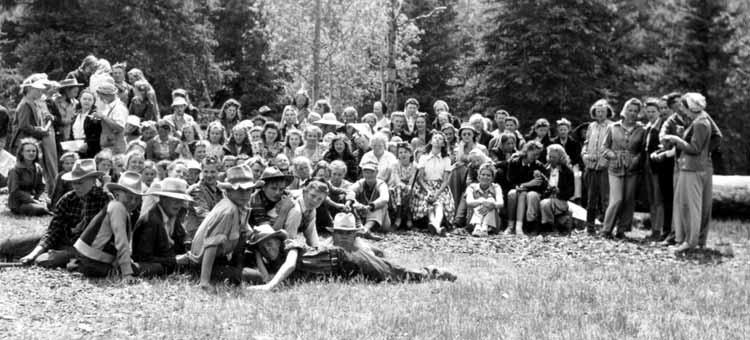
UTAH STATE UNIVERSITY SPECIAL COLLECTIONS
Sponsorship of 4-H programs only increased as the twentieth century progressed. In 1914 the United States Congress passed the Smith-Lever Act. This agricultural support law made more solid and effective the relationship between the land-grant agricultural colleges (created by the Morrill Act of 1862) and county extension agents. Though the Smith- Lever Act did not specifically mention children’s programs, its backing of the Cooperative Extension Service provided a permanent home for the 4-H movement. As 4-H became more established, it received increased private sector aid through the philanthropy of several businesspeople and their corporations. 7 This sponsorship was especially associated with the National Committee on Boys’ and Girls’ Club Work (later renamed “The National Committee”) agribusiness entities such as the Armour and Wilson Packing Companies, and the annual trips to Chicago given to award-winning 4-Hers. Support provided to 4-H from the dominant forces of the new agricultural world was pointed towards creating an ideal agricultural citizen who could and would perpetuate a modernized rural lifestyle.
In 1941 Utah Farmer published a lengthy article by political scientist Arthur Gaeth that supported this utilitarian focus. In “Making Utah Youth More Useful,” Gaeth answered the nagging question of how Utah could take care of its own population. How had generations of European peasants supported themselves through the winter months? Through the production and sale of handiwork they had taught themselves and their children to make leisure-time useful. So it must be in Utah. Farmers had to develop additional sources of income, and for Gaeth the vocational training of youth—as mechanics, mineralogists, and domestic servants—represented the most plausible answer. 8
On paper, 4-H squared with this viewpoint. Instead of depriving farmers of their children’s immediate labor with no recompense to the family income, as programs such as Boy Scouts of America and YMCA reportedly did, 4-H clubs turned children’s socialization into an educational exercise and an addition to the family income. From its inception, 4-H instructed boys and girls not how to amuse themselves, but rather how to implement the latest methods of progressive management so that they might become productive adults. 9
But how did children feel about 4-H? Boys and girls in Utah 4-H turned USDA motives upside-down. For them, leisure-time did not need to be more useful; rather, working hours must become more profitable by becoming “amusements and recreations.” Though it might look like work to adults and outsiders, 4-H was play, not apprenticeship. During the 1940s and 1950s, Utah Farmer published personal success stories written by 4-Hers. These youths voiced the reality that constant toil and economic hardship circumscribed their lives and that they used 4-H to transform those necessary drudgeries into cherished hobbies.
Historian Bernard Mergen framed an essay about the change in American children’s culture caused by the industrial manufacture of toys with two contrasting quotes. The first came from a nineteenth-century Connecticut man, who looked back on the joy found in his boyhood as he learned how to manipulate his favorite of toys—a penknife he used to whittle. The second, from a child of the 1940s, claimed that the author’s “prized possession was a white leather two-gun holster, studded with fake stones.” 10 The 4-Hers who wrote for Utah Farmer lived at the same time as the owner of that flashy holster, yet their playthings hardly resembled his. While young people throughout post-war America turned to television and myriad commercial toys for amusement, many Utahns, like the whittling Connecticut Yankee, used the tools and techniques of adult labor to create pastimes for themselves.
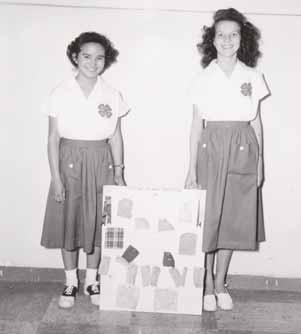
Katharine Naranjo (l) and Martha Ann Yelenich, Carbon County winning demonstration team, Spring Canyon, 1948.
Because of the methods employed by their families and communities to sustain life, the recreation of many 4-Hers had practical ends and fit into a pattern of critical family-based labor. The experiences of three young women demonstrated this utilitarian element. At thirteen years old, Julene Bunker of Millard County shouldered a great deal of responsibility during her mother’s illness. This included washing and ironing the family’s clothing and the preparation of numerous meals, in addition to school attendance. Bunker’s habits of work only increased throughout her teenage years, when she “had the chance” to sew eighty and repair one hundred articles of clothing, prepare nearly five hundred meals, and preserve three hundred quarts of produce. 11
Milford’s Lenora Bowen presented similar statistics of her “inside” work. Beginning in the eighth grade, she did all of her own darning, ironing, and sewing, which included the annual remodeling of old clothing into a new wardrobe. Each year Bowen and her mother preserved approximately six hundred quarts of fruits and vegetables. After Bowen enrolled in 4-H, she often canned on her own, especially when she kept house for her grandfather. Finally, Bowen ran her parents’ household from time-to-time, during which she cleaned, ironed, and cooked, “sometimes for as many as eight men.” 12
Joan Patten, as eldest daughter, assumed full management of her family’s Utah County home after her mother’s death. As a 4-Her for four years before her mother’s passing, Patten gained competency in the tasks that became her daily duties. In her five years of club work, Patten made and repaired nearly two hundred articles of clothing, “prepared 1903 meals, 140 separate dishes, 100 lunches, baked 200 items, froze 200 pounds of food and canned 1598 quarts of fruit.” 13 After her mother’s death and in addition to driving the tractor, chopping wood, tending stock, attending high school, and gardening (for 1185 hours), Patten did all of the cooking, mending, shopping, washing and ironing for a family of six. Her unpaid labor sustained the family.

UTAH STATE UNIVERSITY SPECIAL COLLECTIONS
Though these girls did not limit themselves to domestic endeavors— Bowen fondly described the pleasure she received from livestock and agriculture—their inside work played a major role in family subsistence. Those dazzling numbers of quarts canned by 4-H girls represented part of a crucial survival strategy used by farm women throughout America to support their families. For instance, a pattern of self-sufficiency through utilizing home-grown and preserved food prevailed at several income levels of Wisconsin agricultural families during the 1920s and 1930s. 14 So it was with many young women of rural Utah in the 1940s and 1950s who canned and gardened for their families and for themselves.
Mary Mae Winters, who equated her life with her 4-H involvement— “To tell you something of my experiences and achievements in 4-H Club work is little less than to tell you my life story,”—described with glee a five season canning career that culminated in her preservation of 541 quarts and 28 glass jars of fruits, vegetables, meats, and garnishes in 1942. These products mattered to the Winters who lived thirty-five miles from a city and depended on the canned goods for eight months of the year. According to Winters, her projects saved the family more than one hundred dollars per annum. But Winters’ work also mattered to herself. She forbade that her first pint of canned fruit be placed alongside others at home, because to Winters “it was something very special.” When another girl defeated her at the county canning exhibition one year, Winters redoubled her efforts, which resulted in blue ribbons at county and state exhibits the following year. Winters reflected that when a judge named her the state canning champion, it was “Without exception . . . the happiest moment of my life!” 15
Mary Mae and others recognized the necessity of mundane toil in their rural lives and often used 4-H to make that work an avenue to personal and social fulfillment. Joan Patten, for instance, somehow found time between home management, farm work, and school to attend fifty-two of sixty-one 4-H club meetings. Further, Patten received significant public recognition for her efforts through awards, newspaper articles, and especially, the chance to ride as queen on a 4-H float. Patten told an instructive story. Those who enrolled in and stayed with 4-H did so because it gave entertainment and the thrill of achievement. 4-H represented a way for children from isolated and often marginal areas to attain success, mix with their communities, and go beyond local circumstances.
Complete with small towns, small incomes, and a tangible need for inexpensive leisure, eastern Utah’s Carbon County was an area with high potential for the 4-H programs. Carbon County formed a cultural island in Utah. Mormon farmers settled the first communities in the county, but by the early twentieth century, coal mining dominated Carbon’s economic landscape. With “King Coal” came mining camps, company towns, and demographic diversity.
The people in Carbon County’s towns and mining camps developed an active community life largely based in low-cost and voluntary associations. Ida Jewkes described the coal camp of Kenilworth as a friendly place that offered “the most beautiful way to live.” At the heart of the community was an amusement hall that housed a confectionary and a barber shop, as well as religious services, picture shows, and union meetings. How did organizations fit into this “most beautiful” of lifestyles? 16
Fraternal orders, women’s auxiliaries, ethnic associations, and interest-centered clubs such as the Castle Gate Brass Band, Stella d’America, Daughters of the Utah Pioneers, and the Rusty Dozen Club flourished in Carbon County. Gender played an important role in these groups. Men joined lodges and unions, but the most vital male organizations proved to be the wildly popular local baseball teams. 17 In contrast, many people connected clubs to women. When Jewkes described club life in the mining camps, she explained their importance to women for socializing: “There were several different clubs, hard clubs, sewing clubs, all kinds of things for the women to do.” 18
In the 1940s and 1950s, accounts of bridge parties, sewing circles, and auxiliary meetings dominated the society pages of local newspapers; indeed, male names hardly appeared in those columns except to indicate a woman’s marital status. In Carbon County at mid-century, men recreated through nationally organized associations and athletics, while women created a network of less formal, but equally lively, gender-based clubs.
Children also needed something to do and youth organizations—Little League baseball, Mormon primary, Boy Scouts, Campfire Girls, and 4-H— served to fill the social and educational niches in their lives. 19 4-H began in Carbon communities in 1927, petered out during the Great Depression, and revived again in 1937. A decade later and with some three hundred children enrolled, 4-H represented “one of the leading activities” for Carbon youth. 20 By 1958, 4-H boasted 640 members in the county and had long claimed broad community support. The story of Carbon County 4-H during those twenty years highlights how public agencies and private interests, adults and children, responded to youth work. Public support of 4-Hers abounded in Carbon County. Led by county agricultural agent Robert Hassell, radio stations, newspapers, government offices, labor unions, service clubs, schools, churches, merchants, and other public entities combined in sponsorship of 4-H as a wholesome, constructive program to improve Carbon’s young people. The Sun-Advocate, the county’s major newspaper, gave 4-H significant attention. Local businesses and bankers provided 4-Hers with scholarships, travel money, and awards. Shops allowed 4-H displays to be placed in their windows during “Achievement Week,” and Catholic, Mormon, and Methodist churches permitted 4-H exercises to take place within their halls. 21 When the boys and girls of the Pick ‘n Scratch Poultry Club entered the “Chicken of Tomorrow” contest, the Carbon Locker Market proudly sold the meat and asked customers to “give our 4-H boys a boost and have a chicken fry.” 22 Financial support did not come only from bankers and merchants: in 1952, seven mining union locals financed a banquet for 4-H leaders.
Why did 4-H receive such broad-based backing? Perhaps businesses and organizations appreciated the badge of goodness that aid to children afforded them. Perhaps these sponsors simply enjoyed helping boys and girls. Certainly, some of Carbon’s adults echoed a recurrent theme of youth clubs that 4-H kept children occupied and out of trouble. In 1948 the Sun- Advocate printed a several-page spread dedicated to 4-H which prominently displayed a paragraph that claimed 4-H was a “great stride in the direction of good citizenship and useful living.” 23 America’s troubles with deviant teenagers could not threaten youngsters who devoted their energies and spare time to 4- H style pursuits. Similarly, a 1954 editorial claimed that 4- H curbed juvenile delinquency: “We have our problems in Price—but not with 4-H children.” 24

UTAH STATE UNIVERSITY SPECIAL COLLECTIONS
Though businesses and institutions gladly sponsored young people, county employees often experienced difficulty in getting adults to take actual responsibility for 4-H clubs. When 4-H enrollment dropped, inadequate leadership was often the limiting factor. 25 In 1941 the home demonstration agent reported a significant problem with “…more requests for girls’ clubs in Price and Wellington than leaders willing.” 26 Similarly, in 1950, Hassell recorded that 4-H drives had successfully excited the interest of numerous boys (male membership doubled that year) and many others wanted to join, “but additional leaders could not be found.” 27 A lack of consistently dedicated adults especially hampered the progress of boys’ clubs, and Hassell or older 4-H boys often stepped in to guide these floundering organizations. Obtaining the help of individual adults–not banks, markets, or unions—with the weekly maintenance of 4-H clubs represented a challenging task.
In contrast, the Carbon County extension service had little difficulty recruiting children because for these boys and girls from failing mining camps, provincial towns, and alkaline farms, 4-H offered an opportunity for low-cost fun. Their 4-H associations generally met once a week and consisted of five to ten children, plus one or two leaders. Each child optimally held a position in his or her club—sometimes a rather inventive one, like that of Joseph Bonacci, organist in a gardening group—and each club chose its own name. T. S. S. (of secret meaning), Classy Cookies Clothing, Jolly Half Dozen, Jolly Stitchers, Stylish Stitchers, Stitch and Rip, Snappy Scissors, Little Forest Men, Happy Sewing Bees, Four Busy Bees, Busy Beavers, and the Panhandlers: these names, often reflective of current gender norms, also reflected the enthusiasm and imagination of the children. Carbon County children used 4-H not only as a way to create networks within individual clubs, but also as a stepping-stool into the larger society. In increasing numbers, 4-H members flocked to the annual picnics and camps sponsored by the county. A 1950 picnic held at Price City Park, for instance, entertained 538 4-Hers with games, soft drinks, and square dancing. Four years later, 787 boys, girls, leaders, and parents attended the picnic. 28 Such events became opportunities for community building, and 4-H put children in the center of the activity. Yet involvement in the Carbon community often meant transcending what that area offered them. In the post-war United States, ever-increasing technological advances changed the nature of recreation. Instead of spending their leisure time outdoors, more and more children chose to amuse themselves indoors by watching television. 29 Carbon 4-Hers, small-town seamstresses and cultivators whose pastimes were essentially work, wanted in on that urban-style fun.
In the winter of 1952, boys and girls from Spring Glen and Carbonville saw the realization of a goal for which they had worked long and hard since the previous summer—the purchase of a movie projector. The campaign began with garden club boys growing vegetables and boys and girls preserving that produce to use at banquets. By hosting dinners and bake sales, the children earned the money they needed for their coveted projector. Finally, after sufficient funds had been raised, the 4-Hers watched the film “Million Dollar Week End” free of charge. 30 The children who bought their own million dollar weekend came from two unincorporated, far from prosperous, agricultural communities: theirs was a concerted effort to go beyond the economic and geographic boundaries of their lives by creating their own entertainment.
Children’s manufacture of diversion through voluntary associations fit neatly with well-established social patterns in Carbon County. In the mining camps and farming villages of the region, organizations figured large in local news. Reports of Boy Scout encampments, lodge conventions, ball games, or club dinners occupied a prominent space in newspapers such as the Price Sun-Advocate and Dragerton Tribune. 4-H held its own in these columns. In June 1952, reports of a 4-H picnic and the Tack-L-Tylers, Sewing Eight, Panhandlers, Jolly Stitchers, Stitch and Rip, and Merry Mixers clubs highlighted the Spring Glen news column that also included accounts of wedding receptions, fishing trips, church services, house guests, and vacations. 31
Organizations became especially important in the areas outside of Price and Helper, the main commercial centers. The Dragerton Tribune, which served the mining-centered region of East Carbon, attested to this. The opening of Little League in East Carbon headlined a typical front page of the 1950s and was joined by news of Beta Sigma Phi’s founders’ day banquet, the tight competition between the Geneva Steel and Airport Service bowling leagues, morning services at the Episcopal church, Rotary Club clean-up week, and the 4-H Needle and Thread club’s meeting. 32 The Tribune’s reports of 4-H clubs like the Needle and Thread, the Thimblettes, Buttons and Bows, Sunnyside Stitchers, and Little Mothers bore significant resemblance to descriptions of adult women’s activities. Moreover, girls’ clubs became increasingly prolific in the isolated East Carbon settlements of Dragerton, Columbia, and Sunnyside during the 1950s. In 1957 those communities respectively saw thirty-three, six, and sixteen girls involved in 4-H; by 1958, the numbers had changed to sixty-eight, seven, and thirty. 33 These girls socialized like their mothers did and the networks of female companionship only grew in importance over time.
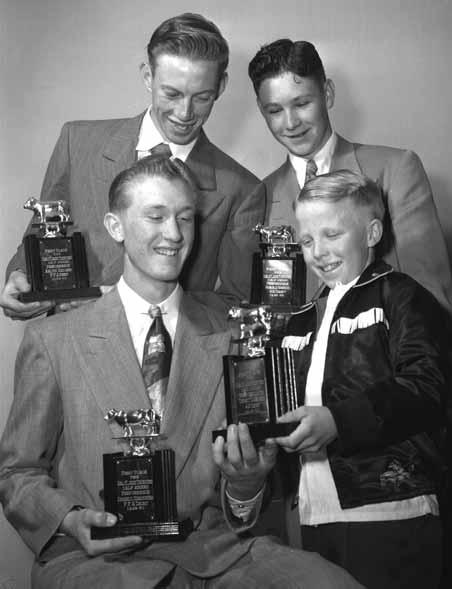
UTAH STATE UNIVERSITY SPECIAL COLLECTIONS
In contrast, only four Dragerton and twelve Sunnyside boys joined 4-H in 1957; the following year, one that saw so much expansion for girls’ clubs, eleven and six boys enrolled. What did boys do for fun while young women cooked, sewed, and built friendships? Consider the opening of Little League in East Carbon. Throughout Carbon County, athletics represented the most recognized form of boys’ organized social life. Though young men at mid-century joined 4-H and organizations like the Boy Scouts, baseball, basketball, and other sports clubs took the limelight. 34

UTAH STATE UNIVERSITY SPECIAL COLLECTIONS
The East Carbon towns that in 1957 could only muster sufficient leaders and seventeen boys for three 4-H clubs, boasted five Little League baseball teams and eight male managers in 1955. 35 Such teams excited adult involvement, as evidenced by a 1955 editorial that reminded emotional parents that “Little League [was] for the kids.” 36 The difference between heated editorials about baseball teams and the “crying need” for 4-H leadership must have rankled Robert Hassell, who complained that baseball took farm and town boys away from 4-H and that, while inadequate adult guidance limited boys’ clubs, “less competition from Western League baseball would also be helpful." 37 The substantial participation of boys and men on these teams, compared with the host of girls’ clubs, matched the pattern of gender-segregated group socializing practiced by Carbon County’s adults. Girls joined the network of women’s clubs, and boys joined the men’s arena of athletic competition. 38
Children’s organized recreation mirrored the adult community in another way—economics. Mining camps represented the majority of Carbon County communities, and in these camps economic and geographic realities did not allow for ambitious crop or livestock projects. Throughout the 1950s, traditional farm-based projects struggled to attract children— especially boys—while less expensive or less vocational projects, such as fly-tying and junior leadership, flourished. 39 Perhaps this would have concerned the 4-H proponents who looked down on the Indian crafts and good times of the Boy Scouts, but 4-H agents and volunteers in Carbon County recognized that mining children required something and that something was not modern farming.
Hassell and the female-dominated leaders’ association explicitly campaigned to increase the number of 4-Hers in the camps. They reached this goal with difficulty because the fluctuating postwar coal market caused unemployment and transience, and therefore a lack of 4-H leaders. 40 In 1954 the association challenged itself to establish a certain number of clubs in nine mining camps. Here economy and idealism came head to head. In Scofield and Castle Gate no clubs functioned because the mines only operated “one or two days a week and people in these towns were trying to move to other sections of the county to obtain work.” 41 When 4-H did succeed in such communities, it was through a conscious promotion of non-farm projects. In 1948 Chester Swanson had stellar success leading boys in Kenilworth (a coal camp with a population of 700) in carpentry. In 1953, “fly-tying continued to interest the boys in the mining [regions].” 42 Arid, alkaline, and married to a resource-extractive industry, Carbon County simply was not the golden land of family farms publicized by progressive reformers. This region had certain needs and its residents—on their own terms—used 4-H to fulfill them.
Like Carbon County 4-Hers, adolescents throughout Utah used 4-H not only to make rural work tolerable and to socialize locally, but also as a tool to enjoy acquaintances, achievements, and pleasures outside of their isolated home towns. For instance, in the 1940s and 1950s, county-wide or combined-county outings became tremendously popular with children. 43 At these events, 4-Hers built temporary communities even as they made crafts and learned campfire songs. Ever learning the principles of democracy, the children elected a government for the three-day encampment. To those elected, leadership represented not only a civics exercise, but, more notably, a badge of acceptance. Jo Ann Leonard of Price, a much-awarded girl, counted her election to camp mayor the “highest honor” and “greatest thrill” of her 4-H career. Leonard’s peers “liked . . .her,” a thing she would not forget “for a long time.” 44 Adults praised 4-H campers for their cleanliness and manageability, but at encampments, children relished new friends, peer recognition, and vacation time. 45
The excitement that public achievement created for Jo Ann Leonard signaled one of the great motivations for 4-H involvement. In their Utah Farmer-published stories, numerous champions described the thrill of winning and connected that feeling to their dedication to 4-H. Janice Paulick wrote of the pleasure she experienced at receiving a blue ribbon, “I was just dazed! For three years I had . . . [wondered] what it would be like to be [a winner]. Now I WAS one! Was it possible? I guess it must be TRUE!” 46 Other writers appreciated college scholarships, junior leadership, artistic release, and education. At a 1960 conference to explore why significant numbers of adolescents left 4-H around fourteen years of age, extension agents asked youth delegates why they had continued project work. The delegates gave a number of telling, and familiar responses: the friends from around Utah, leadership opportunities, major awards, summer activities, training, and goals realized through 4-H. 47 Though many 4-Hers dropped out after one or two seasons of work, those who remained faithful did so because commitment meant accomplishment. They had won “life’s blue ribbons.” 48
Blue ribbons were not everything, though. The majority of children who joined 4-H for a single season, or stayed with the program throughout their teenage years, did so for one controlling purpose—fun. The 1960 youth delegates provided a number of methods to encourage re-enrollment that prominently listed incentives such as mixed-gender projects, more social and recreational events, and “special activities just for older members.” 49 Similarly, when Helen June Funk recounted her 1948 trip to Washington, D.C., she wrote most fondly about other teenagers she had met. After describing 4-H headquarters, group discussions, and speakers, Funk wistfully remarked about her new peers and wished “we had had a few more social dances or parties.” 50 Even teenagers dedicated to their 4-H careers showed more interest in forming new friendships and attending parties than in becoming inculcated with the principles of modern living.
In 1963 Dorothy Kirk Hansen, a University of Utah graduate student, asked Davis County girls why they enrolled in 4-H. Did they join because mothers desired it, friends or siblings were in 4-H, to learn, to become good homemakers, or to have fun? One-hundred and eighty-eight girls, ages nine to fourteen, overwhelmingly responded that they enrolled to have fun. This motivation had influenced girls of all ages, from farm or non-farm homes, and those who joined for one year or four. Eighty-six percent of nineteen farm girls and 73 percent of non-farm girls marked this answer. Sixty-nine percent of first-year 4-Hers and 92 percent of thirdyear girls gave “fun” as their reason for participation. Though not to the exclusion of other reasons, entertainment formed the paramount attraction for 4-H membership. 51
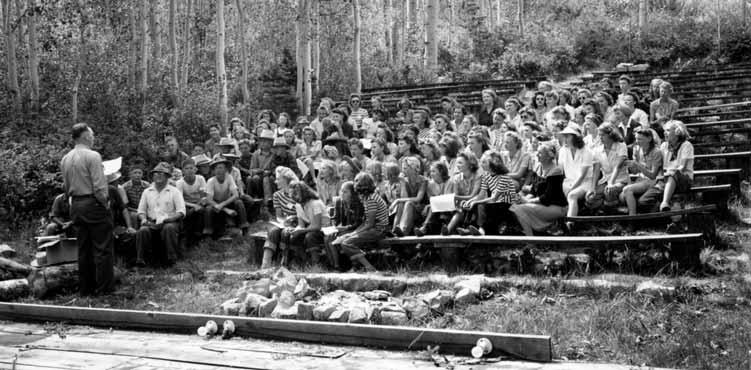
UTAH STATE UNIVERSITY SPECIAL COLLECTIONS
That entertainment often had a certain color to it—the rural reaching for the urban. Though 4-Hers used ovens, needles, and shovels in place of the non-practical playthings of their contemporaries, they still wanted urban diversions. Sponsored travel to state and national level competitions allowed 4-Hers a rare opportunity to feel cosmopolitan, and these excursions represented one of the major pulls of 4-H. Even the chance to sleep in a hotel attracted children. Numerous 4-H winners mentioned the specific name of Salt Lake City’s Newhouse Hotel in their articles. At twelve years old, Janice Paulick of Tooele went to Salt Lake City and stayed in a hotel for the first time. This opportunity formed an exciting moment in Paulick’s life as she and a friend “had to see everything [and] . . . rode up and down the elevator a dozen times.” 52
Marlene Baker of Minersville told a similar story. Her fourth year of 4-H work resulted in a trip packed with many firsts. “I had never been to Salt Lake City and I guess I really acted like it. We stayed at the Newhouse hotel . . .and I rode the elevators almost constantly.” In ardent language, Baker claimed she would “remember it always.” She evidently did recall the fun of that vacation, because two years later, when “financial malnutrition” threatened Baker’s ability to attend state competitions, she and a friend tenaciously raised the needed money. The girls “launched upon the idea of giving a children’s dance . . . in Minersville,” popped corn, made candy, hired a pianist and “cleared about $15 apiece, which we considered very good. . . .” Funds in hand, Baker had “another wonderful trip.” 53
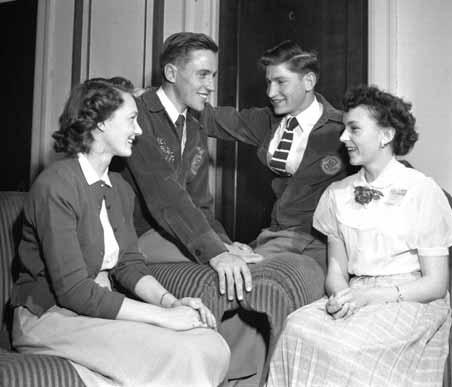
4-H conventions provided opportunities for teenagers and others to meet and socialize, March 1951.
SALT LAKE TRIBUNE COLLECTION, UTAH STATE HISTORICAL SOCIETY
Baker signified the value of 4-H travel by entitling her article “4-H Made Me Aware of the World Around Me.” Photographs of other adolescents on 4-H trips demonstrated that they too enjoyed becoming part of the world around them. The Utah winners who attended a five-day 1964 national 4-H congress in Chicago stayed at the spacious and well-appointed Conrad Hilton Hotel with 1,500 other teenagers. During the daytime, youths from Providence and Riverton wore tailored clothing and sleek hairstyles as they met executives from prominent corporations, participated in news conferences, and demonstrated their prowess in fashion and farming to an appreciative audience. And in the evenings, they danced and danced with new friends their own age. 54 At state and national conventions successful 4-Hers experienced things that their struggling little towns could not offer, and when 4-H gave them the chance to spend time in post buildings, have contact with important public figures, appear on television, or simply ride an elevator, they eagerly seized the opportunity.
What would the reformers, professors, and corporate giants, who saw 4-H as an answer to economic woes and a school for future agriculturists, think of these stories and statistics? What could they think of them? Children turned adult goals upside down and appropriated 4-H for their own purposes, purposes that placed individual success and entertainment above modern farming or efficient housekeeping. 4-H began as a program to give country boys vocational training in progressive agriculture. Instead, women and girls came to dominate 4-H membership, non-farm children increasingly joined in the same numbers as farm children, projects became tailored to meet the needs of non-agricultural and urban members, and children transformed vocational training into a good time.
NOTES
Holly Buck grew up in southern Idaho and received an M.A.in history from Utah State University. This article was adapted from her master’s thesis, “’Winning Life’s Blue Ribbons’: Gender, Recreation, and Utah Children, 1940-1960.”
1 Wanda Campbell,“4-H Clubs And Community Living,” Utah Farmer,April 10,1942.
2 Dorothy Kirk Hansen,“A Study of the Re-enrollment of Girls Who Enrolled in the 4-H Club Program in Davis County in 1963,”(M.S.thesis,University of Utah,1969),61-64.
3 William L.Bowers, The Country Life Movement in America,1900-1920 (Port Washington,New York: Kennikat Press,1974),13.
4 Ibid.,13-14.
5 Thomas Wessel and Marilyn Wessel, 4-H:An American Idea,1900-1980:A History of 4-H (Chevy Chase,Maryland:National 4-H Council,1982),2-6.Bowers, Country Life Movement,51.
6 Janice Nahra Friedel,“Jessie Field Shambaugh:The Mother of 4-H,” Palimpsest 62 (1981):99.
7 Wessell, 4-H:An American Idea,22-35.
8 Arthur Gaeth,“Making Utah Youth More Useful,” Utah Farmer,April 25,1941.
9 Wessel, 4-H:An American Idea, 2-7.
10 Elliott West and Paula Petrik,eds. Small Worlds:Children and Adolescents in America,1850-1950 (Lawrence:University Press of Kansas,1992),86.
11 Julene Bunker,“4-H Trains for Effective Living,” Utah Farmer,April 13,1952.
12 Lenora Alice Bowen,“My 4-H Club Experiences and My 4-H Project Achievements,” Utah Farmer, November 10,1943.
13 “Two Utah Girls Win National Honors,” Utah Farmer,December 15,1948.
14 Mary Neth, Preserving the Family Farm:Women, Community,and the Foundations of Agribusiness in the Midwest,1900-1940.(Baltimore:Johns Hopkins University Press,1995),32.
15 Mary Mae Winters,“4-H Canning Champion Tells How Efforts Begets Reward,” Utah Farmer , February 10,1942.
16 Ida and Thelma Jewkes,interview,February 21,1979,MSS A 2965,4,Utah State Historical Society, Salt Lake City,Utah (USHS).
17 Ronald G.Watt, A History of Carbon County (Salt Lake City:Utah State Historical Society and Carbon County Commission,1997),347-57,331-38.
18 Jewkes interview,5.
19 Watt, Carbon County,193.
20 Theta Johnson and Edna N.Peacock,“History of 4-H Clubs in Carbon County,”in Centennial Echoes from Carbon County,ed.Thursa Jessen Reynolds (Salt Lake City:Daughters of the Utah Pioneers,1948), 117-21.
21 Utah Cooperative Extension Service Papers (UCES),19.1/1:47,boxes 13 and 14,Merrill Library Special Collections and Archives,Utah State University,Logan,Utah (hereafter cited as USUA).
22 Sun-Advocate,June 19,1952.
23 Ibid,July 29,1948.
24 UCES 19.17/13,box 2,1954 folder,51,USUA.
25 UCES 19.1/1:47,box 14,1956 folder,5,USUA.
26 UCES 19.1/1:47,box 13,1941 folder,13,23,USUA.
27 UCES 19.1/1:47,box 1 1950 folder,17,USUA.
28 UCES 19.1/1:47,box 14,1950 and 1954 folders,USUA.
29 Elliott West, Growing Up in Twentieth-Century America:A History and Reference Guide (Westport, Connecticut:Greenwood Press,1996),192-94.
30 Sun-Advocate,January 31,1952.
31 “4-H Clubs Highlight Spring Glen News,” Sun-Advocate,June 26,1952.
32 Dragerton Tribune, May 10,1955.
33 UCES 19.1/1:47,box 14,1958 folder,17,USUA.
The 1948 Carbon district BSA encampment attracted nine troops,a total attendance of 102 scouts and eight Scouters.Boys overwhelmingly formed the membership of these troops.“Carbon Boy Scouts Conclude Most Successful Encampment,” Sun-Advocate ,July 29,1948.Sixty-five scouts and leaders attended a 1957 district “camporal.” Dragerton Tribune,July 23,1957.
35 “May 14th Marks Opening of Little League in East Carbon,” Dragerton Tribune,May 10,1955.
36 “Little League is for the Kids,” Sun-Advocate,June 30,1955.
37 UCES 19.1/1:47,box 14,1959 folder,30,and 1956 folder,5,USUA.
38 This gender-defined pattern bears significant resemblance to social-life trends in Butte,Montana, another mining town;Mary Murphy, Mining Cultures:Men,Women,and Leisure in Butte,1914-41 (Urbana: University of Illinois Press,1997).
39 In 1955,for instance,27 children enrolled in vegetable growing,54 in fishing,and 23 in junior leadership clubs,compared to 10 in dairy,10 in beef,and 2 in sheep clubs.UCES 19.1/1:47,box 14,1955 folder,25,USUA.
40 Floyd A.O’Neil,“Victims of Demand:The Vagaries of the Carbon County Coal Industry,”in Carbon County:Eastern Utah’s Industrialized Island,ed.Philip F.Notarianni (Price,Utah:Carbon County Historical Society,1981),22-39.Watt, Carbon County,123.
41 UCES 19.1/1:47,box 14,1954 folder,4.
42 Sun-Advocate,July 29,1948.UCES 19.1/1:47,box 14,1953 folder,17,USUA.
43 Daniel A.John,“Utah 4-H,a Dynamic Youth Program,” Utah Historical Quarterly 51 (Spring 1983): 181-82.
44 Jo Ann Leonard,“Yes–Work Put into 4-H Pays Off,” Utah Farmer,November 6,1952.
45 David Sharp,Jr.,“Activities As an Extension Officer,”interview by Charles S.Peterson,May 18,1972, MSS 23,USUA.
46 Janice A.Paulick,“That Wasn’t All–The Best Was Yet to Come!” Utah Farmer,November 20,1952.
47 UCES 19.17/13,box 2,1960 folder,8-9,USUA.
48 Carolyn Bromley,“Winning Life’s Blue Ribbons,” Utah Farmer,October 16,1952.
49 UCES 19.17/13,box 2,1960 folder,8-9,USUA.
50 Helen June Funk,“4-H’ers View of National Camp,” Utah Farmer,August 15,1948.
51 Hansen,“Re-enrollment of Girls,”61-64.
52 Paulick,“That Wasn’t All,” Utah Farmer,31.Likewise,Marva Gribble reported about the excitement created by staying with other young women at the Salt Lake City hotel,“what a time we did have!”Marva Gribble,“Farmerette Studies Beef-Raising Techniques,” Utah Farmer,June 5,1952.
53 Marlene Baker,“4-H Made Me Aware of the World Around Me,” Utah Farmer, December 4,1952.
54“4-H News:the 43rd National 4-H Club Congress,”November 29 and December 3,1964,courtesy of Glenn T.Baird,Logan,Utah.



